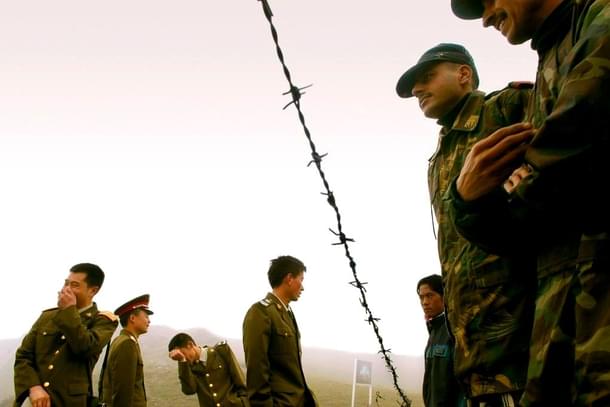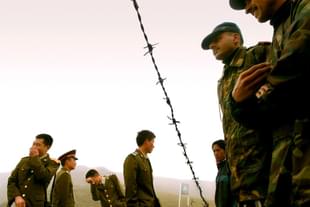Defence
Explained: A Year After The Galwan Clash, Increased Militarisation Of The LAC Is The New Normal
Swarajya Staff
Jun 15, 2021, 12:40 PM | Updated 12:39 PM IST
Save & read from anywhere!
Bookmark stories for easy access on any device or the Swarajya app.


A year after the 15 June clash in the Galwan Valley — the worst violence on the India-China border since 1967 — the crisis in Eastern Ladakh is far from over.
While Indian and Chinese forces deployed on the north bank of the Pangong Lake and the peaks of the Kailash Range have disengaged, the standoff continues in Gogra-Hot Springs and Depsang Plains. Despite the relative calm along the Line of Actual Control (LAC) over the last few months, de-escalation is not in sight.
On both sides of the LAC, forces are now deeply entrenched, and new infrastructure has come up to sustain the unprecedented deployment of troops and equipment.
China Reinforcing Positions In Depth Areas
China has been quietly reinforcing its presence in depth areas along the LAC to support its troops deployed at friction points.
China has built permanent structures between Kangxiwar, which is located on the Xinjiang-Tibet (G219) highway just north of Aksai Chin, and Rudok, a town in Tibet just south of the eastern end of Pangong Lake.
Positions have been reinforced in Xaidulla, a town located on the G219 highway, 94 kilometres from the Karakoram Pass, and Kyrmmgo Traggar, across the LAC from Hot Springs and Gogra. A radar site in Piue, located just across from Ladakh's Chip Chap Valley, has also been strengthened by the Chinese.
At Kangxiwar and Rudok, the PLA has brought in 10,000 additional temporary troops to support the 10,000 permanent Chinese troops deployed at these locations, intelligence estimates say.
China has also strengthened its positions in the depth areas near the Spanggur Lake, which is located east of Chushul and south of Pangong Tso. The Kailash Range, on which Indian troops had occupied tactically advantageous positions in August last year, is located just west of the Spanggur Lake.
The People’s Liberation Army Air Force (PLAAF) has upgraded infrastructure at its bases on the Tibetan Plateau. For instance, at the Ngari Gunsa airbase close to Ladakh, located only 200 kilometres away from the Pangong Lake, China is constructing hardened aircraft shelters at the base, used for shielding fighter jets from enemy missiles and bombs.
China has finished upgrading the main surface-to-air missile (SAM) site adjacent to the Lhasa Gonggar airport, which also serves as a major base for the PLAAF on the Tibetan Plateau. The airbase is located at a distance of around 200 kilometres from Arunachal Pradesh and nearly 300 kilometres from Sikkim.
More recently, the Chinese air force held a major exercise in Tibet, in which over a squadron worth of fighter jets, including J-11s and J-16s, participated. Infrastructure added by the PLAAF at airbases in Tibet over the last year was used during this exercise.
China has also been rotating troops deployed along the LAC. Earlier this year, it rotated two large formations by inducting two fresh divisions. The 4th and 6th divisions of the People’s Liberation Army deployed in Aksai Chin, part of the Xinjiang Military Division, were replaced with the 8th and 11th divisions.
These development suggest China does not plan to go back from friction points such as Gogra and Hot Springs anytime soon, a message that the Indian side came back with from the 11th round of talks with the Chinese in April.
Indian Troop Levels In Ladakh Same As At Peak Of The Standoff
India continues to maintain the troop levels — 50,000 to 60,000 soldiers — that it had in Ladakh at the height of the crisis last year. The heavy equipment, including tanks, armoured personnel carriers and artillery, remains deployed.
The Indian Air Force, too, has maintained its posture, with fighter aircraft, including Mig-29s, Su-30s and the newly-inducted Rafales, and Apache attack helicopters.
Last month, Army Chief General Manoj Mukund Naravane said ongoing standoff with China may not end anytime soon and troops should be ready for a long deployment.
“Disengagement has happened but there has been no de-escalation. So that’s why the troop strength, the numbers in that whole area of the northern front, and when I say northern front, it is not just Eastern Ladakh, the whole front, right from Ladakh down to Arunachal. So, the whole front will see this enhanced presence till such time that we keep talking and the de-escalation happens,” the Army Chief said recently, hinting at a new normal along the Himalayan frontier between India and China.
Both India and China will have to contend with the new strategic reality — increased militarisation of the LAC. Given the distrust of China, a result of its actions last year, India will need a heavier military posture in Ladakh and improved infrastructure to enable rapid mobilisation of troops to the LAC.
The LAC is likely to continue to remain hot as the crisis shows no signs of abating.





